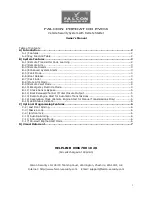
CA-15 In an oil fired furnace, when do I measure
smoke?
Smoke is best measured when the burners have
stabilized, normally one minute after ignition for small
combustion equipment.
CA-16 Can oil furnaces and boilers produce CO?
Oil burners, and any other piece of combustion equip-
ment, will produce CO (carbon monoxide) when there
is not sufficient mixing of O
2
and fuel for complete
combustion.
C O M B U S T I O N S A F E T Y
CS-1
What is Carbon Monoxide (CO) and where is
it found?
Carbon Monoxide (CO) is a highly toxic, lighter than air
gas which is most often found in an area surrounding a
combustion source (a furnace, boiler or space heater)
where there is insufficient oxygen to allow for complete
combustion of the fuel in use.
Carbon Monoxide is very dangerous because it is color-
less, odorless, tasteless, and non-irritating. It is virtually
impossible to detect Carbon Monoxide without a test-
ing instrument.
Carbon Monoxide is also flammable and burns in air
with a bright blue flame.
CS-2
How dangerous is Carbon Monoxide?
Carbon Monoxide is very dangerous: over 800 people
die each year from CO poisoning in the United States.
Most of us know that high levels of CO are harmful.
What is less well known is that CO is a cumulative poi-
son. CO can slowly build up in the bloodstream. In the
bloodstream CO combines with blood hemoglobin and
replaces the oxygen in the bloodstream until there is
too little oxygen in the bloodstream to support life.
Some of the danger signs of CO poisoning are
:
headaches, dizziness, tiredness, and nausea. Frequently,
CO poisoning is confused with other diseases because
the symptoms are similar to flu or the common cold.
Death from CO poisoning can happen suddenly.
Victims of CO poisoning are overcome and helpless
before they realize that any danger exists.
We have included a chart which illustrates the effects of
CO at various PPM and hours of exposure (chart #9).
5
Chart 7
R E L AT I ON S H I P B E T W E EN O
2
, CO
2
A N D E X C E S S A IR
Chart 9
E F F E C T S O F C A RB O N M ON O X I D E
Chart 8
BU R N E R PE R F OR M AN C E
Smo ke S ca l e
R e a d i n g
1
Excellent – Little, if any, sooting of furnace or boiler
s u rf a c e s .
2
Good – May be slight sooting with some types of furnace
or boiler but little increase in flue gas temperature.
3
Fair – Substantial sooting with some types of furnace or
boiler and require cleaning more than once a year on
most types of furnace or boiler.
4
Poor – This is a borderline smoke-some units may soot
only moderately, others may soot rapidly.
5
Very Poor – Heavy sooting in all cases- may require
cleaning several times during the season.
6
Extremely Poor – Severe and rapid sooting-may result in
damage to stack control and reduce overfire draft to
danger point.

































